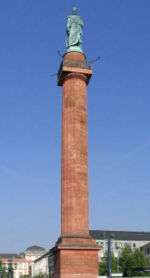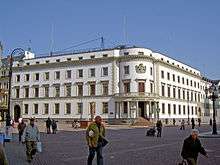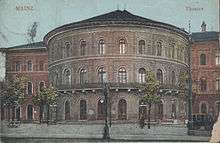Georg Moller
| Georg Moller | |
|---|---|
 Georg Moller, prior to 1852 | |
| Born |
21 January 1784 Diepholz |
| Died |
13 March 1852 (aged 68) Darmstadt |
| Occupation | Architect |
| Buildings | |
Georg Moller (21 January 1784 – 13 March 1852) was an architect and a town planner who worked in the South of Germany, mostly in the region today known as Hessen.
Life and family background
Moller was born in Diepholz, a descendant of an old Norwegian family of clergy, who were known in the 17th century for publishing evangelical songbooks. His father, Levin Adolf Moller, grew up in Westphalia and became a notary in Celle, and by 1777 worked as an advocate and attorney-at-law in Diepholz. Moller's mother, Elisabeth von Castelmur, originated in an old Swiss family of nobility from the Upper Engadin district of Switzerland. Therefore, Moller grew up in a well-situated family.
In 1800, after finishing grammar-school Moller began studying architecture with Christian Ludwig Witte in Hannover. Here he was introduced to Friedrich Weinbrenner whom he followed to Karlsruhe in 1802, to continue studies at a school for building trades. During the years 1807–1809 Moller took a study trip to Rome where he gained crucial insight from members of the Romancolony of German artists. After finishing this journey he became a construction superintendent in 1810 and was hired as court master builder of the Grand Duchy of Hesse.
Between his major works in this function are St. Ludwig, the first Roman Catholic church building in Darmstadt since the Reformation—a building whose forms were inspired by the Pantheon in Rome—the former Landestheater, the Luisenplatz and the Masonic Lodge, what today is the „Moller-Haus“. Furthermore, he designed the Staatstheater Mainz, which created some stir because of its half-round facade and the Stadtschloss Wiesbaden of the Dukes of Nassau, today the seat of the Landtag of Hesse. 1843–1847 Moller was commissioned by Grand-Duke Ludwig II. to overview the restoration of Schloss Biedenkopf.
Only two of Georg Moller's major works survived the second world war without damages: the grand-ducal mausoleum at the Rosenhöhe and the Ludwigsäule on the Luisenplatz, both of them in Darmstadt. The other buildings Moller designed were damaged beyond repair or were reconstructed in a more simple design.
Moller also did the reconstruction of the castles in Bad Homburg and Meisenheimer, the latter called Wolfgangsbau, for the Landgrave of Hesse-Homburg. He also worked for prince Klemens von Metternich when he redesigned his Schloss Johannisberg. He worked in Hannover as well.
Moller is considered, along with Karl Friedrich Schinkel and Leo von Klenze, as one of the most important German architects working in the Greek Revival and Romanticist styles. His inventiveness as an engineer and as a composer of space is most visible in the Ludwigskirche in Darmstadt.
Aside his work as an architect Moller was successful as a preserver of buildings. He was at least partly responsible for preserving the Carolingian Torhalle in Lorsch, which today is part of the UNESCO World Heritage Site. Moller in 1818 convinced the Grand-Duke of Hessen-Darmstadt to edict the first ordinance of preservation of ancient buildings, the first law concerning the protection of historic buildings in Germany. His well-known book Denkmäler der Deutschen Baukunst ("Milestones in German architecture"; 1815-1851) was advanced for his time. He also wrote Beiträge zu der Lehre von den Konstruktionen (“Contributions to knowledge on construction”; 1833-1844).
Moller also played an important role for the completion of Cologne Cathedral. It was he who discovered one half of the original 13.25 feet (4.04 m) facade drawing by cathedral masterbuilder Arnold in an attic near Darmstadt, while the other half was found by Sulpiz Boisserée in Paris in 1816. The uncompleted cathedral was completed in accordance with these designs.
Moller died in Darmstadt, aged 68.
Architects Georg Moller educated
- Rudolf Wiegmann
- Gottfried Bandhauer (possible)
Gallery
 Ludwigsmonument in Darmstadt
Ludwigsmonument in Darmstadt Ludwigskirche in Darmstadt
Ludwigskirche in Darmstadt

Literature
- Reinhard Wegner (1994), "Moller, Georg", Neue Deutsche Biographie (NDB) (in German), 17, Berlin: Duncker & Humblot, pp. 742–744
- Bernd Krimmel: Darmstadt in der Zeit des Klassizismus und der Romantik. Hess. Staatsarchiv Darmstadt, 1979
- Eckhart G. Franz: Georg Moller. Hess. Staatsarchiv Darmstadt
-
 Gilman, D. C.; Thurston, H. T.; Colby, F. M., eds. (1905). "Moller, Georg". New International Encyclopedia (1st ed.). New York: Dodd, Mead.
Gilman, D. C.; Thurston, H. T.; Colby, F. M., eds. (1905). "Moller, Georg". New International Encyclopedia (1st ed.). New York: Dodd, Mead.
External links
| Wikimedia Commons has media related to Georg Moller. |
- Georg Moller in the German National Library catalogue
-
 "Moller, Georg". The American Cyclopædia. 1879.
"Moller, Georg". The American Cyclopædia. 1879.